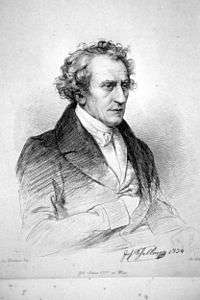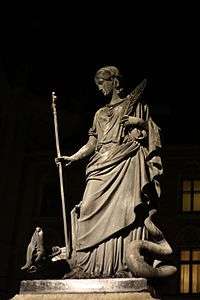Johann Nepomuk Schaller


Johann Nepomuk Schaller (30 March 1777, Vienna - 16 February 1842, Vienna) was an Austrian sculptor. His most famous work is a bust of Beethoven, created at the request of the composer's friend Karl Holz. It was later presented to the Royal Philharmonic Society, London, on the occasion of the Beethoven Centennial.
Life
He was the younger brother of the painter Anton Ferdinand Schaller (1773-1844). From 1789, he attended the Academy of Fine Arts, Vienna where he studied under Hubert Maurer. In 1791, he became an apprentice at the Vienna Porcelain Manufactory.[1] The following year, he began to study sculpture with Franz Anton von Zauner. By 1811, he had become the head of modelling at the factory. Despite his turn to sculpture, he retained his love for porcelain and acted as an artistic advisor to the factory for the rest of his life.
From 1812-1823, he lived in Rome on a grant from Prince Metternich, obtained for him by a patron, Count Carl Ludwig Cobenzl.[1] While there, he became familiar with the Nazarene movement as well as making professional contact with Antonio Canova and Bertel Thorvaldsen. He politely refused an offer from King Ludwig I to come work for him in Munich.
In 1823, he returned to Vienna, having accepted a position as Professor of Sculpture at the Academy. His most famous student there was Joseph Gasser von Valhorn. He died after a brief illness that was not believed to be serious.[1] A street in the Viennese district of Meidling was named after him in 1907.
Selected major works
- Der jugendliche Amor (The Young Cupid) (Vienna, Österreichische Galerie Belvedere, Inv. Nr. 4202), 1815/16
- Bellerophon im Kampf mit der Chimaira (Bellerophon Fighting the Chimera) (Vienna, Österreichische Galerie Belvedere), 1821
- Statue of Andreas Hofer, (Hofkirche, Innsbruck, 1827–33
- Margaretenbrunnen (Margaret the Virgin, fountain), Vienna, 1836
References
- 1 2 3 Hyacinth Holland (1890), "Schaller, Johann Nepomuk", Allgemeine Deutsche Biographie (ADB) (in German), 30, Leipzig: Duncker & Humblot, pp. 561–562
Further reading
- Selma Krasa-Florian: Johann Nepomuk Schaller 1777-1842. Ein Wiener Bildhauer aus dem Freundeskreis der Nazarener. Vienna: Schroll, 1977, ISBN 3-7031-0409-0
- Schaller, Johann Nepomuk, in Constant von Wurzbach, Biographisches Lexikon des Kaiserthums Oesterreich, Vol.29, Vienna 1875. (Fraktur)
- Selma Krasa-Florian: "Schaller Johann Nep.". In: Österreichisches Biographisches Lexikon 1815–1950 (ÖBL). Vol. 10, Austrian Academy of Sciences, Vienna 1994, ISBN 3-7001-2186-5, p. 34 f. (Direct links to "p. 34", "p. 35")
External links
| Wikimedia Commons has media related to Johann Nepomuk Schaller. |
- The Red List: More works by Schaller
- Royal Academy of Music: Beethoven's bust
- Literature by and about Johann Nepomuk Schaller in the German National Library catalogue